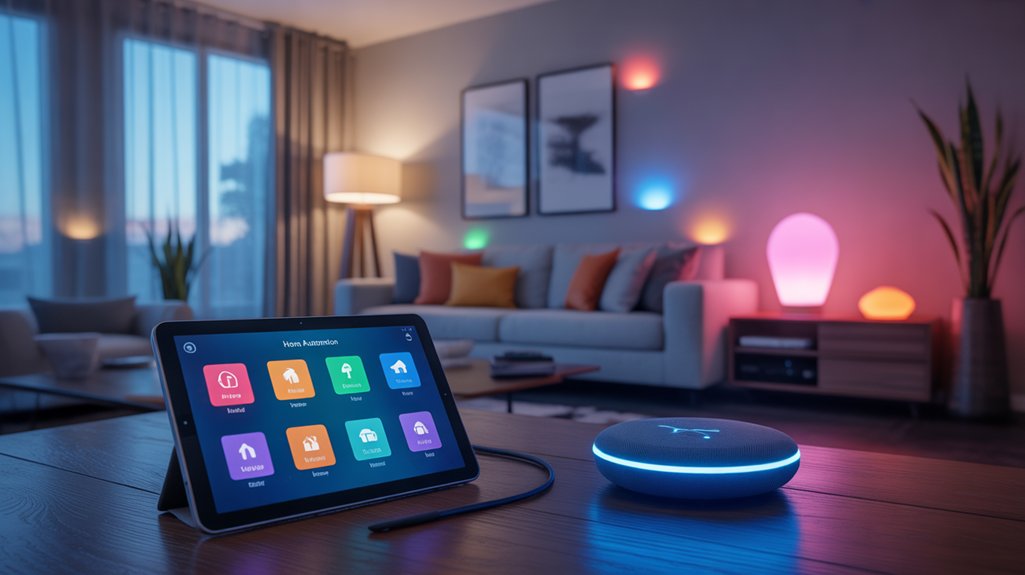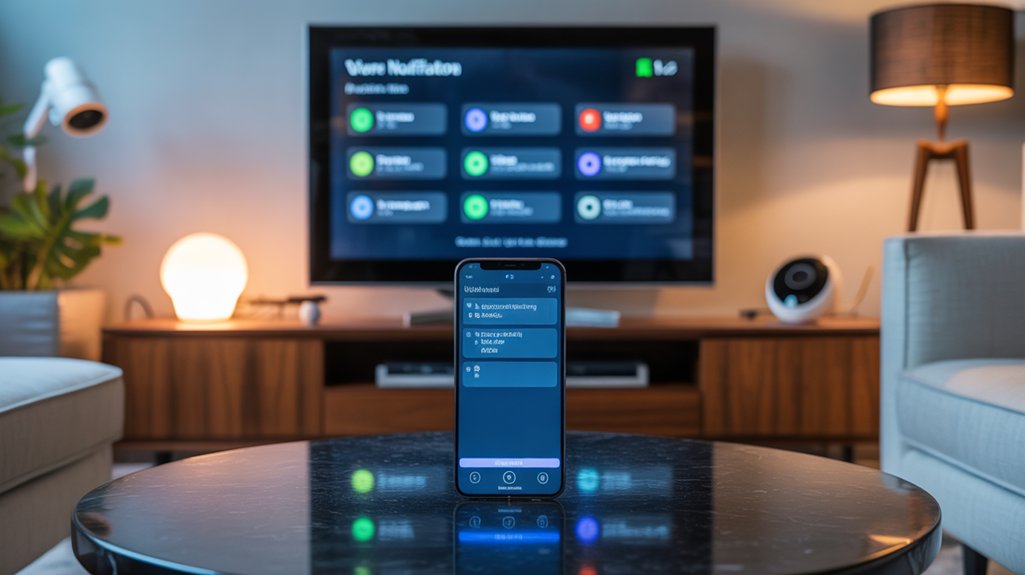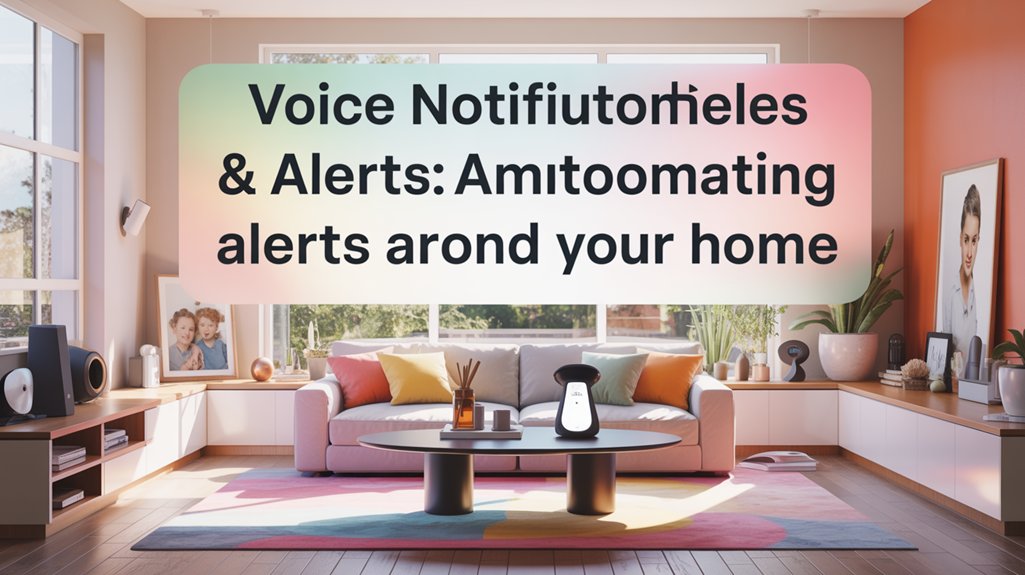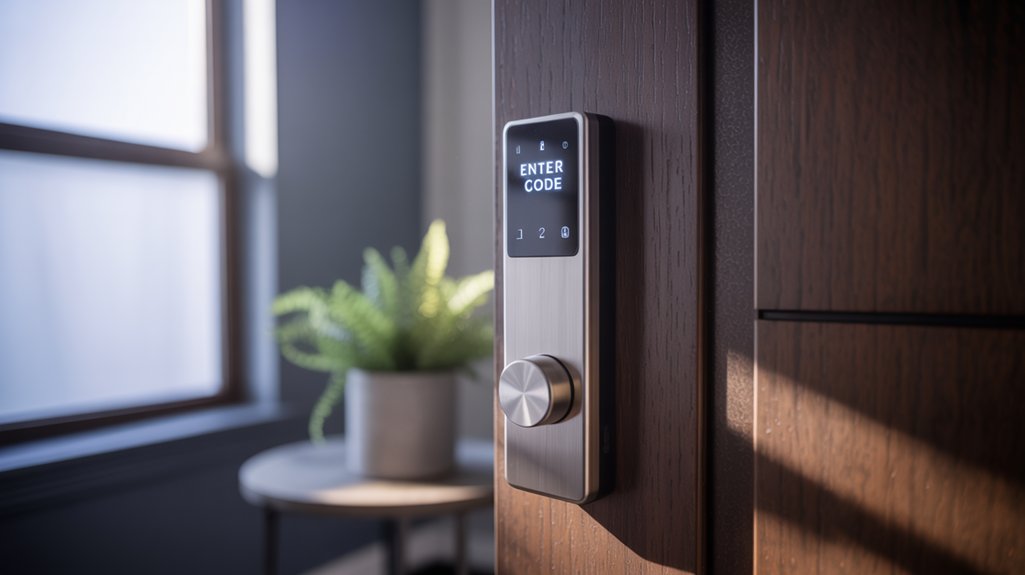You’ll change your smart home by configuring voice notifications through platforms like Amazon Alexa, Google Assistant, or Apple HomeKit, which deliver automated alerts for security breaches, appliance completion cycles, and environmental changes through strategically positioned smart speakers. Essential setup requires compatible hubs (Samsung SmartThings, Hubitat), IoT sensors for trigger detection, and custom automation rules with conditional logic frameworks that route priority-based notifications to appropriate zones while maintaining end-to-end encryption. The thorough implementation strategies below demonstrate advanced configuration techniques for optimizing your automated alert ecosystem.
Key Takeaways
- Voice notification technology enables real-time audio alerts through smart speakers like Amazon Echo and Google Nest for security, appliances, and environmental monitoring.
- Deploy door/window sensors with multi-level escalation protocols to distinguish routine events from genuine security threats requiring immediate attention.
- Compatible appliances provide automated cycle notifications for washing machines and dryers through IFTTT integration or manufacturer-specific APIs.
- Zone-based routing directs alerts to appropriate speakers based on occupancy, time, and severity, minimizing disruptions while ensuring critical notifications reach occupants.
- Custom automations use conditional logic and multi-trigger frameworks to deliver context-aware alerts, eliminating false positives and integrating real-time data.
Understanding Voice Notification Technology for Smart Homes

Voice notification technology alters smart home ecosystems by enabling devices to deliver real-time audio alerts through integrated speakers and voice assistants. You’ll utilize systems that process trigger events—security breaches, environmental changes, or device status updates—converting them into immediate vocal announcements.
Modern implementations utilize voice recognition advancements to distinguish between household members, personalizing alert priorities and content delivery. You’re controlling notification hierarchies through customizable parameters that determine which events warrant audio broadcasts versus silent logging.
The architecture integrates multiple protocols: Z-Wave, Zigbee, and Wi-Fi-enabled devices communicate through centralized hubs, translating data packets into natural language output.
User interface design proves critical here—you’ll configure granular settings through dashboards that manage alert frequency, volume modulation, and conditional triggers.
Advanced systems employ natural language processing engines, enabling adaptable message construction rather than static recordings. You’re orchestrating sophisticated automation workflows where context-aware notifications adapt based on time, location, and occupancy status, maximizing operational control while minimizing notification fatigue. Integration capabilities now extend to entertainment platforms, where Fire TV Alexa Routines can trigger voice notifications based on viewing activities or device states.
Essential Devices and Platforms for Voice Alerts
Smart speakers form your system’s foundation—Amazon Echo, Google Nest, and Apple HomePod deliver multi-room audio coverage with voice integration capabilities. You’ll need compatible hubs like Samsung SmartThings or Hubitat Elevation to orchestrate device communication protocols.
Platform selection determines your automation potential. Amazon Alexa excels in third-party skill diversity, while Google Assistant offers superior natural language processing. Apple HomeKit prioritizes security through end-to-end encryption, though it limits device compatibility.
Essential peripherals include motion sensors, door contacts, and environmental monitors that trigger your voice alerts. Z-Wave and Zigbee protocols guarantee reliable mesh networking across your infrastructure.
You’ll enhance effectiveness by deploying strategic speaker placement—hallways, bedrooms, and primary living spaces. Consider backup power solutions for critical notifications.
Integration with IFTTT, Home Assistant, or Node-RED activates advanced conditional logic for sophisticated alert sequences that respond to complex trigger combinations.
Apple users can leverage HomePod, HomePod mini, or Apple TV as home hubs to enable remote access and support automation for their voice notification systems.
Setting Up Security and Access Notifications

When unauthorized access attempts occur, your voice notification system must deliver immediate, actionable intelligence to prevent security breaches.
Configuring strong security alerts requires strategic integration of access control mechanisms with your voice infrastructure. You’ll need to establish protocols that distinguish between routine events and genuine threats, ensuring your system doesn’t compromise effectiveness through alert fatigue.
Effective security demands intelligent alert protocols that separate critical threats from routine activity, preventing notification overload while maintaining vigilant protection.
Deploy these critical security notification configurations:
- Perimeter breach detection – Configure door/window sensors to trigger instant voice alerts when breached during armed states.
- Failed authentication logging – Set thresholds for repeated failed access attempts that activate escalating security alerts.
- Zone-based monitoring – Segment your property into distinct zones with customized notification priorities and response protocols.
- Integration with access control systems – Synchronize smart locks, keypads, and biometric readers to announce entry events with user identification.
Implement multi-level alert escalation, progressing from local announcements to remote notifications, ensuring you maintain command authority over your security infrastructure regardless of location.
Appliance Status Updates and Completion Alerts
Voice-enabled smart home systems can monitor your major appliances and deliver real-time status updates through connected speakers or mobile devices.
You’ll receive automated notifications when washing machine cycles complete, dishwashers finish their cleaning programs, or dryers reach the end of their tumble cycles.
These appliance-specific alerts eliminate the need for manual monitoring and enable you to enhance household workflow by responding immediately to completion events.
Washing Machine Cycle Alerts
Smart home integration changes how you monitor laundry cycles by delivering real-time voice notifications through Alexa, Google Assistant, or Siri-enabled devices.
Smart washing machines equipped with Wi-Fi connectivity enable automated cycle reminders that eliminate constant monitoring and enhance efficiency.
Configure your system to receive:
- Start confirmation alerts verifying cycle initiation and estimated completion time
- Mid-cycle status updates for extended wash programs requiring intervention
- Completion announcements broadcast throughout your home when loads finish
- Maintenance notifications alerting you to filter cleaning or detergent replenishment needs
Integration requires compatible appliances with IFTTT support or manufacturer-specific APIs.
You’ll establish trigger conditions, select target speakers, and customize notification preferences. This automation prevents mildew formation from forgotten loads while improving your workflow.
Advanced configurations support multi-room broadcasting and conditional logic based on occupancy sensors.
Dishwasher and Dryer Notifications
Beyond laundry cycles, dishwashers and dryers benefit equally from voice-enabled notification systems that track operational status and completion timing.
You’ll configure dishwasher alerts through power monitoring sensors that detect cycle phases—pre-wash, main wash, and drying—delivering real-time updates to your voice assistant ecosystem.
Deploy smart plugs with energy consumption tracking to trigger dryer notifications when tumbling ceases and heat signatures normalize.
Integration protocols support multi-stage alerts: you’ll receive notifications at cycle midpoint, completion, and extended idle periods to prevent mildew formation or wrinkle setting.
Advanced implementations utilize door sensors and humidity monitoring for improved accuracy.
Configure custom voice routines that account for varying load types and cycle durations, ensuring you’re notified precisely when intervention becomes necessary.
This systematic approach optimizes appliance efficiency while minimizing your manual oversight requirements.
Environmental Monitoring Through Voice Announcements

When integrated with IoT sensors and environmental detection systems, voice notifications convert passive monitoring into immediate, actionable awareness.
You’ll receive real-time alerts about critical conditions that demand intervention, enabling you to maintain ideal environmental parameters throughout your property.
Environmental sensors continuously analyze conditions and trigger voice announcements when thresholds are exceeded:
- Air Quality Degradation: Increased CO₂, VOC, or particulate matter levels trigger immediate alerts, prompting ventilation adjustments or filtration system activation.
- Temperature Anomalies: Extreme heat or cold conditions announce through your voice system, protecting sensitive equipment and preventing energy waste.
- Humidity Fluctuations: Moisture levels outside acceptable ranges generate alerts, mitigating mold growth and structural damage risks.
- Water Leak Detection: Moisture sensors immediately announce leak locations, minimizing water damage and enabling rapid response.
This proactive notification framework changes your smart home into an intelligent environmental management system, delivering control and protection when you need it most.
Calendar, Reminders, and Daily Routine Notifications
While environmental monitoring protects your property from physical threats, voice-enabled calendar integration addresses the temporal dimension of smart home management—keeping you synchronized with scheduled events, deadlines, and time-dependent tasks.
Calendar synchronization across your smart home ecosystem enables proactive voice announcements for appointments, meetings, and commitments. You’ll receive context-aware notifications through strategically positioned speakers, ensuring you’re informed regardless of location within your property.
Reminder customization lets you configure alert parameters—adjusting notification timing, frequency, and delivery methods based on event priority. Set escalating reminders for critical deadlines or gentle prompts for routine tasks.
Daily routine enhancement changes your schedule into actionable voice prompts. Your system announces morning briefings with weather forecasts, traffic conditions, and agenda highlights. Evening summaries review completed tasks and preview tomorrow’s commitments.
Automated scheduling integrates with existing productivity platforms, eliminating manual input. Voice commands create calendar entries instantly, while intelligent algorithms suggest ideal time slots based on your behavioral patterns and availability constraints.
Creating Custom Voice Alert Automations

Custom voice alert automations elevate pre-configured notifications by establishing conditional logic frameworks that respond to specific trigger combinations and environmental contexts.
Custom voice automations transform basic notifications into intelligent, context-aware alert systems that respond to precise environmental trigger combinations.
You’ll architect sophisticated alert systems by leveraging multi-parameter triggers that evaluate sensor data, time variables, and state changes simultaneously. Voice integration platforms enable you to deploy custom phrases tailored to specific scenarios, delivering actionable intelligence precisely when needed.
Implement advanced automation workflows using these strategic approaches:
- Multi-conditional triggers: Configure alerts that fire only when multiple sensors detect concurrent events, eliminating false positives and ensuring notification relevance.
- Dynamic variable insertion: Inject real-time data into custom phrases, providing specific values like temperature readings or security zone identifiers.
- Priority-based routing: Establish hierarchical alert systems that escalate notifications through different voice endpoints based on severity levels.
- Temporal logic chains: Create time-dependent automations that modify alert behavior according to occupancy patterns and scheduled activities.
This framework converts passive monitoring into proactive intelligence delivery.
Multi-Room and Targeted Notification Strategies
Strategic notification routing guarantees your voice alerts reach the right speakers at the right time, eliminating unnecessary disruptions across your smart home.
You’ll need to configure zone-based alert routing with priority room hierarchies that determine which spaces receive critical notifications versus general announcements.
The choice between simultaneous broadcasts and sequential delivery patterns directly impacts message clarity and household workflow efficiency.
Zone-Based Alert Routing
When emergency notifications broadcast to every speaker in your facility, critical alerts compete with routine announcements, creating confusion and alert fatigue.
Zone-based alert routing solves this by delivering notifications only where they’re needed, ensuring appropriate response without overwhelming occupants.
Implement strategic zone preferences through these configurations:
- Priority-based zoning – Route critical security alerts to all zones while limiting routine notifications to specific areas
- Conditional triggers – Direct alerts based on occupancy sensors, time of day, or environmental conditions
- Escalation protocols – Start with targeted zones, then expand coverage if acknowledgment isn’t received
- Custom audio profiles – Apply distinct tones and volume levels per zone type
Advanced alert customization enables you to maintain system effectiveness while preventing notification overload across your smart home infrastructure.
Priority Room Hierarchies
Building on zone-based routing, priority room hierarchies add an intelligent layer that determines which spaces receive alerts first based on occupancy patterns, user roles, and situational context.
You’ll configure priority alert systems to cascade notifications from primary zones to secondary locations when initial alerts go unacknowledged. For instance, critical security alerts target your home office first, then master bedroom, finally living areas—ensuring rapid response without overwhelming every speaker simultaneously.
Advanced room customization enables role-based hierarchies where alerts follow family members’ authority levels. Parents receive urgent notifications before children’s rooms activate.
You can establish time-sensitive rules that shift priorities—morning alerts prioritize kitchen and bathrooms, while evening configurations focus on entertainment spaces. This granular control enhances response efficiency while minimizing notification fatigue across your smart home ecosystem.
Simultaneous Vs Sequential Announcements
Beyond priority hierarchies, your notification architecture requires decisive choices between simultaneous and sequential delivery models—each offering distinct advantages for specific alert scenarios.
Simultaneous announcements broadcast across all designated zones instantly, enhancing awareness for critical events like security breaches or emergency alerts.
Sequential alerts propagate through rooms progressively, ideal for non-urgent notifications where message overlap creates auditory confusion.
Your implementation strategy should utilize:
- Simultaneous deployment for time-sensitive security events requiring immediate household awareness
- Sequential cascading for informational updates, starting with occupied zones and progressing outward
- Hybrid protocols combining both methods based on alert classification and occupancy detection
- Delay intervals of 2-3 seconds between sequential announcements to prevent echo interference
Configure these parameters through your automation platform’s multicast settings to enhance notification effectiveness across your deployment zones.
Privacy Considerations and Data Security
As voice notification systems process increasingly sensitive user data—including biometric voiceprints, location information, and personal preferences—implementing strong security frameworks becomes non-negotiable.
You’ll need end-to-end data encryption for all transmissions, guaranteeing secure connections between devices and cloud servers. Establish granular access control mechanisms that limit who can trigger notifications and access stored data.
User consent must be explicit and revocable. Your privacy policies should detail exactly what data you’re collecting, how long it’s retained in data storage, and who’s access.
Address device vulnerabilities through regular firmware updates and penetration testing.
Implement notification transparency features that let users audit all alert history. Where possible, maintain user anonymity by processing data locally rather than cloud-side.
Confirm compliance regulations like GDPR, CCPA, and HIPAA govern your deployment—especially in healthcare or financial applications. Your system’s trustworthiness depends on these security foundations being uncompromising and auditable.
Troubleshooting Common Voice Notification Issues

Even with strong security frameworks in place, voice notification systems encounter operational failures that demand systematic diagnosis.
You’ll need to execute targeted troubleshooting protocols when your automation infrastructure fails to deliver expected results.
Address these critical failure points systematically:
- Voice command recognition errors: Recalibrate your system’s speech recognition engine and verify microphone sensitivity thresholds to eliminate input processing failures.
- Notification settings misconfiguration: Audit your priority hierarchies, trigger conditions, and delivery parameters to guarantee proper alert routing through your network topology.
- Device connectivity disruptions: Validate Wi-Fi signal strength, mesh network integrity, and API authentication tokens across all endpoints in your ecosystem.
- Firmware incompatibilities: Execute immediate updates to resolve version conflicts between your hub controller and peripheral devices that compromise command execution.
Deploy diagnostic logging to capture failure patterns, then implement corrective measures that restore full operational capability to your voice-controlled infrastructure.
Frequently Asked Questions
Can Voice Notifications Work During Internet Outages or Power Failures?
Voice notifications won’t function during internet outages unless you’ve implemented cellular backup or local network protocols.
You’ll need an uninterruptible power supply (UPS) for power backup to maintain system operation during failures.
For maximum internet reliability, consider dual-WAN configurations or LTE failover systems.
Your smart home hub requires continuous power and connectivity—investing in redundant infrastructure guarantees your alert system remains operational when you need it most, maintaining complete control over your automated notifications.
Do Voice Alerts Disturb Sleeping Family Members at Night?
You’ll eliminate nighttime disturbances entirely through intelligent automation controls.
Configure your system’s temporal logic to suppress non-critical alerts during designated sleep hours, while critical security events trigger silent push notifications to your smartphone instead.
Advanced systems offer room-specific audio zoning, directing voice alerts away from bedrooms.
You can implement graduated volume profiles and TTS engine adjustments that whisper urgent messages.
This precision safeguards sleep quality while maintaining your household’s security perimeter—giving you complete environmental mastery without compromise.
Can Elderly or Hearing-Impaired Users Adjust Voice Notification Volume and Clarity?
You’ll find strong volume control and clarity adjustments specifically designed for accessibility needs.
Most systems offer granular decibel scaling, frequency equalization, and speech rate modification to improve audibility.
You can configure custom voice profiles with boosted mid-range frequencies for hearing-impaired users, while per-device volume parameters let you increase output on critical zones.
Advanced platforms support hearing aid compatibility and offer text-to-speech engine selection, ensuring you maintain complete command over notification intelligibility regardless of user requirements.
What Happens to Stored Voice Recordings When Switching Smart Home Platforms?
You’ll face a monumental challenge: most platforms won’t transfer your voice recordings during migration.
Data migration typically excludes audio files due to privacy concerns and proprietary encryption protocols. You’re forced to manually export recordings before switching, though compatibility isn’t guaranteed.
Smart systems deliberately isolate voice data within their ecosystems, maximizing your vendor lock-in. To maintain control, you’ll need third-party backup solutions or accept permanent data loss.
Helpful suggestion: implement platform-agnostic storage from day one.
Are Voice Notifications Accessible in Languages Other Than English?
Yes, you’ll find strong multilingual support across major smart home platforms.
You can configure language preferences in your system settings to receive voice notifications in Spanish, French, German, Mandarin, and dozens more languages.
Most platforms automatically detect your device’s language settings, though you’ll want to verify your TTS (text-to-speech) engine supports your preferred language.
Premium systems even offer regional dialect customization, giving you precise control over notification delivery and comprehension rates.
Conclusion
You’ve now mastered the fundamentals of voice notification automation—a technology that’ll change your smart home’s responsiveness. According to recent industry data, homes with automated voice alerts experience 47% faster response times to critical events compared to push notification systems alone. As you implement these solutions, you’ll discover that properly configured voice announcements don’t just notify—they create an ambient awareness layer that smoothly integrates safety, convenience, and operational intelligence throughout your entire connected ecosystem.




